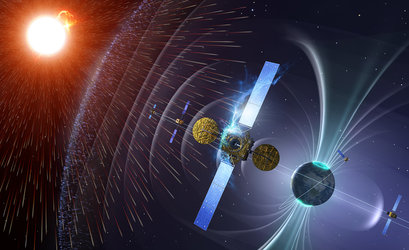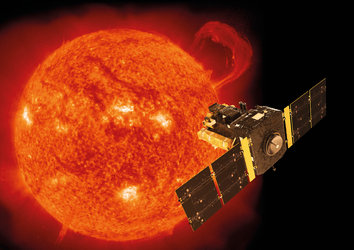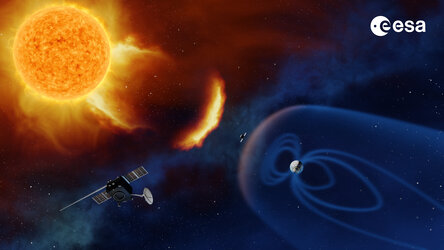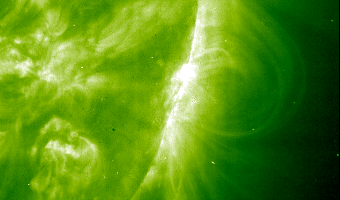Monitoring space weather
Providing timely and accurate space weather information, nowcasts and forecasts is possible only if sufficient observation data are continuously available.
As Earth is well protected against space weather by its magnetic field and the atmosphere, only a limited amount of space weather observations are possible from the surface. For example, our magnetic field deflects most of the solar wind charged particles away from our planet and the atmosphere filters out extreme ultraviolet and X-ray wavelengths from sunlight.
The working approach for ESA's Space Weather Service Network is to collect as much of the required measurement data using ground-based instruments as possible, because ground-based instruments are typically less expensive and easier to maintain and upgrade than spaceborne instruments on board satellites.
However, to gain all the necessary, accurate, realtime data needed for future space-weather warning services, data from instruments in space are also essential.
Watching from Earth

Examples of European and international observatories and instrument networks that could be utilised in ESA's Space Weather Network are shown, as examples, in the table below. More may be added in future.
| Type of data | Source of data |
| Solar images in various wavelengths | Use/reuse existing European solar telescopes such as the Kanzelhöhe Observatory for Solar and Environmental Research, Austria. Expand to global coverage through agreements with, for example, the Global High Resolution H-alpha Network |
| Solar magnetogram images | Use/reuse existing European solar telescopes such as the Instituto de Astrofísica de Canarias (IAC) contribution to the GONG network. Expand to global coverage through agreements with existing assets, e.g. GONG. |
| Solar indices (F10.7) | Solar radiometer − data via Canada's Dominion Radio Astrophysical Observatory (DRAO) |
| Solar radio bursts | Solar radio spectrograph network. Reuse existing assets such as the International Network of Solar Radio Spectrometers (eCALLISTO) |
| Cosmic ray neutron flux (at Earth's surface) | Existing neutron monitor network. Reuse existing assets such as the Neutron Monitor Database hosted by the Extraterrestrial Physics group at the Institute for Experimental and Applied Physics, Christian-Albrechts-Universität, Kiel, Germany |
| Vector magnetic field (Magnetograms at Earth's surface) | Vector magnetometers, such as the International Real-time Magnetic Observatory Network (INTERMAGNET) |
| Total electron content (TEC) maps | GNSS receiver networks. Reuse of existing station networks such EUREF from the International Association of Geodesy (IGS) |
| Auroral visible imaging | Obtain from all-sky imagers. Reuse of imaging systems such as the Finnish Meteorological Institute (FMI) realtime auroral cameras |
| Ionosphere | Sourced from ionospheric sounders such as the European Digital Upper Atmosphere Server (DIAS) network. Obtain complete global coverage through international cooperation agreements. |
| Ionospheric scintillation | Dedicated GNSS receivers for scintillation monitoring. Detectors capable of sampling at the frequency required for scintillation measurement are less widely available and further deployment at high and low latitudes should be considered. |
| Ionospheric electric field | Inchoherent/coherent radar network such as the Super Dual Auroral Radar Network (SuperDARN) and from the European Incoherent SCATter Scientific Association (EISCAT) |
| Ionospheric radio absorption | From riometer networks. Reuse existing assets such as AAR/AIRS in Norway, IRIS in Finland and NORSTAR in Canada |
| Coronal mass ejection (CME) detections through cosmic ray anisotropy | From muon telescope networks such as the Muon Spaceweather Telescope for Anisotropies at Greifswald (MuSTAnG) facility. |
Watching from space

Earth is well protected against the effects of space weather by the magnetic field (magnetosphere) surrounding our planet and by our thick atmosphere.
Our planet's magnetic field deflects the majority of the charged particles and solar wind emitted by the Sun, while the atmosphere filters out the dangerous wavelengths of the Sun’s electromagnetic radiation − such as Extreme Ultraviolet (EUV), X-rays and gamma rays.
For space weather monitoring and forecasting, however, we need observations from where these happen, i.e. from space, and this is why we need spaceborne observation systems to complement ground-based observations.
Flying instruments
ESA's Space Weather Service Network plans to obtain 'in-situ' measurements from space (but inside Earth’s magnetosphere) by using 'hosted payload' instruments − that is, instruments flown on spacecraft operated by ESA or by other organisations, which is a smart way to boost economic efficiency.
For a hosted payload instrument, measurements made from orbit will typically comprise monitoring of particles and fields within the magnetosphere (that is, inside Earth’s magnetic field) and auroral images.
In addition, dedicated 'SmallSat' or 'CubeSat' missions may be needed to complement hosted payload instruments to cover all the needed measurements. The hosted payload instruments and potential SmallSat missions will form the 'Distributed Space Weather Sensor System' (D3S). Observations gathered by D3S will particularly benefit satellite operations, spacecraft engineering, anomalous-event analysis and space-environment impact studies.
Remote sensing from the Lagrange points
Forecasting space weather (predicting conditions in the future) and nowcasting space weather impacts (detecting current conditions) at Earth requires remote sensing of the Sun, the solar corona and the free solar wind outside Earth’s magnetosphere.
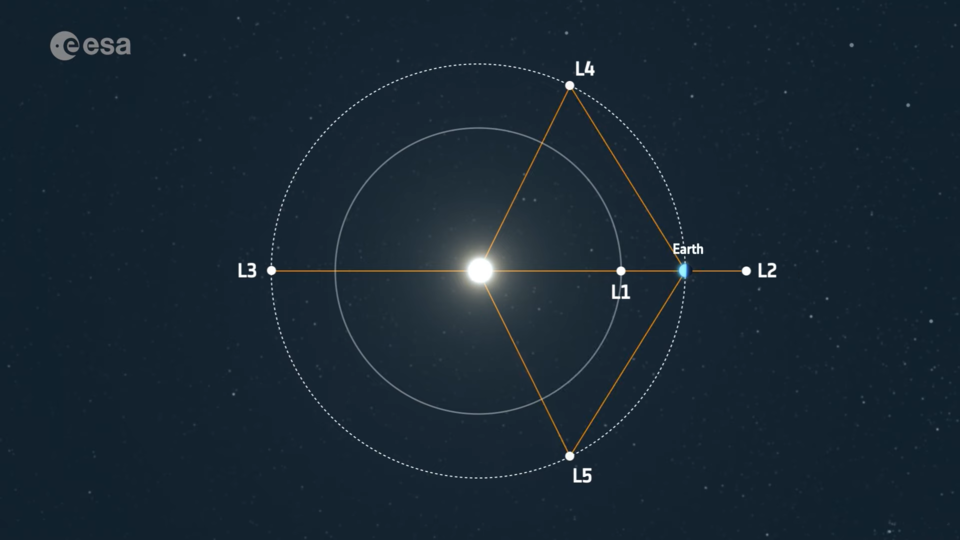
Two of the five Lagrange points of the Sun-Earth system, L1 and L5 are very good locations from which spacecraft can monitor interplanetary space and solar activity. At these points in space, gravitational forces and the orbital motion of the spacecraft, the Sun and Earth interact to create a stable location from which to make observations.
L1 is in the solar wind 'upstream' from Earth, so measurements at L1 provide information about the space weather coming toward Earth. L1 is home to the ESA/NASA Solar and Heliospheric Observatory.
In contrast, the L5 point (located 60 degrees and 150 million km behind Earth, close to its orbit) provides a way to monitor Earth-oriented coronal mass ejections (CMEs) from the 'side' so as to give more precise estimates of the speed and direction of the CME. These measurements can be used to provide space weather warnings, alerts and status information to customers on Earth.
ESA's upcoming Vigil mission will be located at L5. It will complement measurements made from L1 by providing a view of the Sun away from the direct Sun-Earth line. This gives visibility of the propagation of plasma clouds emitted by the Sun toward Earth, as well as views of the solar disk before it rotates into view from Earth. Vigil will ensure ESA's robust capability to monitor, nowcast and forecast potentially dangerous solar events.
Instruments on ESA Vigil
From its unique vantage point in deep space, Vigil will greatly improve our early warning of severe space weather events such as solar storms that may cause disruption on Earth.
The spacecraft and its subsystems are uniquely designed to be able to process the instrument data for an optimal and efficient long-distance data transfer to Earth from deep space without interruption.
The payload suite consists of a mixture of imaging and in situ sensing instruments provided by a mixture of European institutes and industrial partners. In addition to the European instruments, Vigil will carry two instruments from the USA, from NASA and NOAA, strengthening international collaboration.
Vigil's instruments will utilise technologies developed for, and tested on, earlier ESA and joint ESA/NASA solar science missions such as the Solar and Heliospheric Observatory and Solar Orbiter.
The spacecraft is planned for launch in 2031.

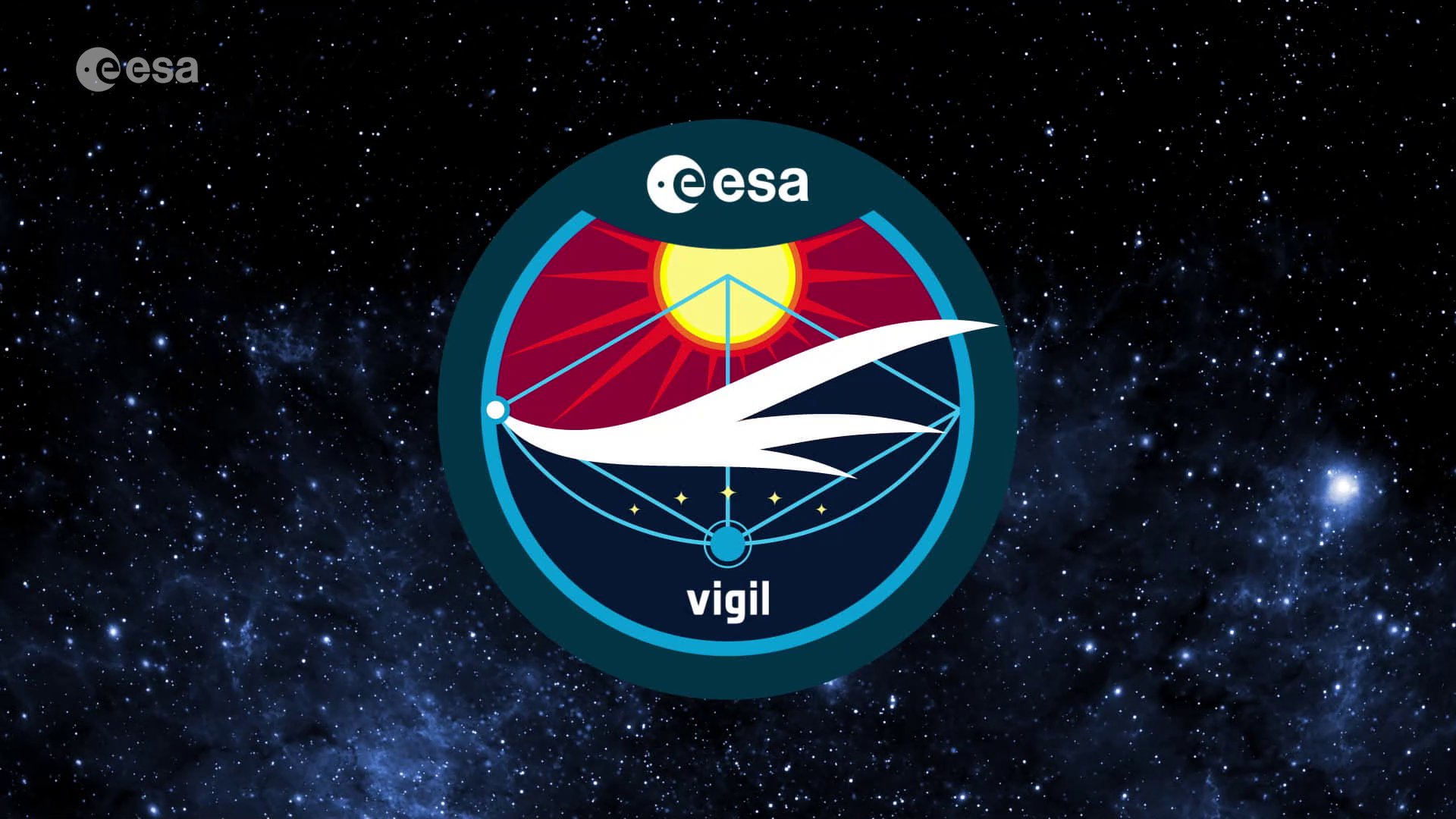
Access the video
The Vigil payload will consist of the following instruments:
Imaging instruments
- Photospheric Magnetographic Imager (Germany), Max Planck Institute for Solar System Research (MPS)
A magnetograph scans a selected spectral absorption line of the solar spectrum, and the data so generated allow the current, three-dimensional magnetic field configuration of the Solar Disc to be established.
- Heliospheric Imager (Italy, Belgium), Leonardo SpA/CSL, Belgium
A wide-angle visible-light imaging system for the detection of coronal mass ejection events in interplanetary space and, in particular, of coronal mass ejection (CME) events directed toward Earth. HI data can be used to improve CME arrival time and effect predictions and monitor CME propagation as it travels toward Earth.
- Compact Coronagraph (USA, NOAA), Naval Research Lab
The onset and characteristics of a CME can be derived from coronagraph imagery and these data are a crucial input for predicting CME arrival times at the Earth and any potential effect on infrastructure.
- Extreme ultraviolet (EUV) Imager ‘JEDI’ (USA, NASA), prime contractor under final selection
Imaging of the complex solar corona (the Sun's atmosphere) will support monitoring of the magnetic complexity and activity in the corona and location of the flaring active regions.
In-situ instruments
- Plasma Analyser (UK), Mullard Space Science Lab
Measures angular velocity components of the solar wind, mostly protons and Helium atoms, in certain energy ranges. This will allow determination of solar wind properties, in particular density, velocity and temperature.
- Magnetometer (UK/Austria), Imperial College London/IWF Graz
Measurement of the interplanetary magnetic field will be essential for monitoring and modelling of its configuration and understanding how it is perturbed by CMEs prior to their arrival at Earth. These measurements are important for forecasting magnetic storms and disturbances caused by interaction of areas with different solar wind velocities. These observations assist space-weather forecasters in interpreting the evolution of the solar wind.
ESA is also planning a number of other space weather satellite missions. Data from ESA space weather missions will be first processed and stored at the Space Weather Data Centre located at ESA Redu, Belgium. The calibrated and verified measurement data will then be disseminated in near-realtime to the teams in the Space Weather Service Network for further processing, validation and utilisation in in customer/end-user applications and services.
For the current space weather status and access to all of ESA's SWE services, access the Space Weather Service Portal.














 Germany
Germany
 Austria
Austria
 Belgium
Belgium
 Denmark
Denmark
 Spain
Spain
 Estonia
Estonia
 Finland
Finland
 France
France
 Greece
Greece
 Hungary
Hungary
 Ireland
Ireland
 Italy
Italy
 Luxembourg
Luxembourg
 Norway
Norway
 The Netherlands
The Netherlands
 Poland
Poland
 Portugal
Portugal
 Czechia
Czechia
 Romania
Romania
 United Kingdom
United Kingdom
 Slovenia
Slovenia
 Sweden
Sweden
 Switzerland
Switzerland


























